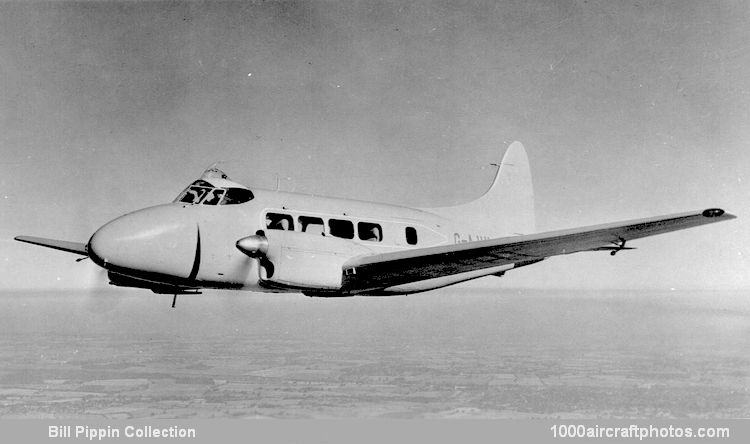03/15/2020. Remarks by Johan Visschedijk: "The Dove was designed to the Brabazon Type 5B Specification to replace the Rapide and to Air Ministry Specification 26/43 as a local service all-metal airliner using for the first time metal to metal bonding. Power came from two de Havilland Gipsy Queen 70 engines driving three-blade D.H. reverse pitch/feathering propellers. The Dove was designed to carry up to eleven passengers in a high density layout and provision was made for two crew. The Dove was ideal for local service scheduled airlines, charter and business use, with modern travelling standards at economic levels of operation and maintenance.
It was designed to fulfil a number of different tasks, including aircrew training, communications, survey, ambulance and pest control, and at a later date, for airways calibration. The military variant was known as the Devon, and all versions operated in a wide range of climatic conditions from the polar circles to the Equator. One Dove was fitted with floats by de Havilland Canada in 1947. The first of two Dove prototypes (G-AGPJ c/n 04000/P-1, G-AGUC c/n 04000/P-2) was first flown on September 25, 1945.
The Dove Mk.1 was the initial airline version and the Mk.2 was the executive equivalent, the first of which was delivered to Vickers in 1948. The Mk.3 was a proposed high-altitude survey version, which was not built, and the Mk.4 became the military Devon to specification C.13/46 which was ordered by the RAF and RN, still continuing in service for communications. Other Devon orders came from India, South Africa and New Zealand.
Among the early airline customers were BOAC, Airwork, Central African Airways and the Airlines of Western Australia. Demand for the Dove grew rapidly, the largest single customer being the Argentine government who ordered a total of 70 aircraft for transport, ambulance duties, and locust control. Doves were used widely throughout Africa, Asia and Europe, followed by North America where they were delivered unpainted and unequipped. They were then completed in various finishing centers for business travel and commuter operations.
In 1953, more powerful Gipsy Queen 70 Mk.2 engines were installed resulting in the Dove Mk.5 for airline use and the executive Mk.6. The aircraft for the American market carried the suffix A after each number, and suffix B covered the rest of the world. The airframe itself changed little, but with these versions role change was made easier. Dove production had started at the Hatfield factory, but was moved to Chester in 1951 to make room for Comet construction.
In the summer of 1960, the six-seat Dove Mk.8 was announced, which featured uprated Gipsy Queen 70 Mk.3 engines, an enlarged Heron type canopy and improved equipment. Not only was the performance improved, but so also was the payload-range capability. The executive Mk.8 first flew in February 1960, and the high density airline version was the Mk.7. This version was only sold in its VIP business aircraft configuration outside North America. In the mid-1960s, the RAF commenced the conversion of most of their Devons to the Mk.8 standard, with the more powerful engines and new canopy.
The last of the 544 Doves to be built was delivered on September 20, 1967, to Dowty Ltd.as G-AVHV (c/n 04542), but it was destroyed when it crashed into houses while landing at Wolverhampton on April 9, 1970.
The pictured aircraft was registered to RAF Air Commodore Whitney Straight of Southall on February 12, 1947, the following September 6, G-AJHL was reregistered to British Overseas Airways Corporation, of which Straight was Chief Executive Officer and managing director. Only five months later, February 9, 1948, the aircraft crashed into the Ionian Sea off Locri in the southern tip of Italy, all occupants were rescued before the aircraft sank."
